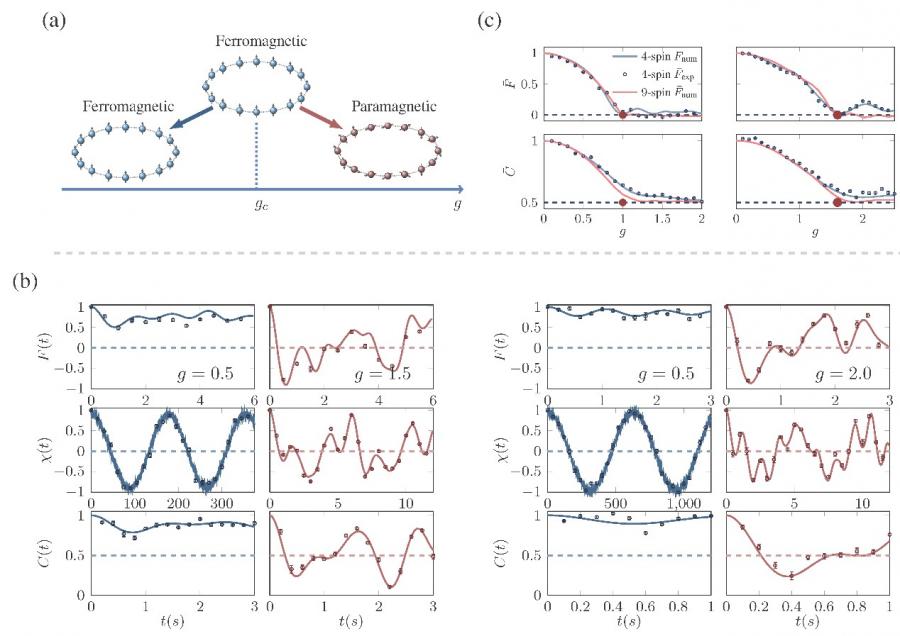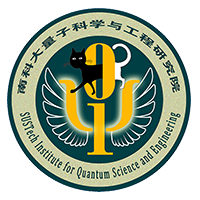Research progress in Detecting quantum phase transition with OTOC
Recently, the Shenzhen Institute for Quantum Science and Engineering (SIQSE) and the Department of physics at Southern University of Science and Technology have made significant experimental progress in detecting quantum phase transition with OTOC. The research team mainly includes Jun Li, the associate researcher of the Institute, Tao Xin, the assistant researcher of the Institute, Dawei Lu, the associate professor of the Department and their cooperator, Bo-Bo Wei, the assistant professor of the Chinese University of Hongkong (Shenzhen).They have observed Equilibrium and dynamical quantum phase transition on a four-qubit nuclear magnetic resonance quantum simulator. The prestigious academic journal, Physical Review Letters, has recently published the research results entitled "Experimental Observation of Equilibrium and Dynamical Quantum Phase Transitions via Out-of-Time-Ordered Correlators."
Quantum phase transition is one of the most significant phenomena in many-body physics. The equilibrium quantum phase transition is always accompanied by the abrupt change of the order parameter and comprehensively understood with the renormalized group theory. Although progress has been made in the equilibrium quantum phase transition, how to thoroughly understand the quantum phase transition happened far from the equilibrium state is a challenging research topic.
In recent years, with the progress of experimental technology, the dynamical quantum phase transition occurred in an isolated system that has attracted the attention and interest of theoretical and experimental researchers. In 2013, Markus Heyl proposed the conception of "dynamical quantum phase transition" (DQPT) for the first time. He pointed out that DQPT can be detected by the nonanalytical change of the rate function of the Loschmidt echo. The research of DQPT is critical to the comprehensive understanding of the non-equilibrium properties of a many-body system. The recent theoretical study proposed a new method to characterize DQPT with the out-of-time-ordered correlator (OTOC). OTOC is a fundamental concept to quantify the quantum information scrambling. Its first experimental measurement was carried out by our group in 2017, the result of which was published in Physical Review X (Phys. Rev. X 7, 031011, 2017).
The research group has studied the dynamical quantum phase transition in both the integrable and the non-integrable transverse-field Ising model via a four-spin quantum simulator. As shown in Fig1. (a), researchers firstly initialized the system to the fully-polarized state, i.e., the ferromagnetic phase. Then, observe the time evolution of OTOC after quenching the system to the ferromagnetic phase or the paramagnetic phase quickly. The experimental results are shown in Fig1. (b) and (c), which indicates that OTOC can be used to detect both dynamical quantum phase transition and the critical point of the equilibrium quantum phase transition. Besides, they also compared the OTOC with the two-body correlation function as an order parameter to detect the quantum phase transition experimentally. It is found that OTOC diagnoses the critical point more precisely than that of the two-body correlation and is also much more robust against quantum decoherence. The first experimental work to study DQPT with OTOC has clarified the profound relationship between OTOC and DQPT and paved the new path for studying the EQPTs through the non-equilibrium quantum quench dynamics with quantum simulators.
Xinfang Nie (a postdoc of the Shenzhen Institute of Quantum Science and Engineering (SIQSE) and the Department of physics at Southern University of Science and Technology) and Bo-Bo Wei are the co-first authors of the paper. Tao Xin, Dawei Lu and Jun Li are corresponding authors. This work was supported by the National Key Research and Development Program of China, the National Natural Science Foundation of China, Guangdong Provincial Key Laboratory and Science, Technology and Innovation Commission of Shenzhen Municipality.




